Rob's Photos of Libya 2006 Total Solar Eclipse
A lot of data was collected this time. The phenomena associated with
the sun span a vast range of brightnesses. The eye can handle all of
these, but film (or CCDs) can only look at a narrow range of brightnesses at
a time. The images below were selected to best show the wide range of
brightnesses and what can be seen at each range.
Most of the images below have been cropped. 10:37:36 is an example of
a full frame image. As you can see there was about 1 1/2 sun diameters
at the top and bottom of the frames.
Click on the thumbnails below for large JPEG images. There are also
uncompressed images available in TIFF format. You can use either Photoshop
or Office Picture Manager (OIS.EXE) to view the TIFF images. I recommend you
stick to the JPEGs unless you have a high speed Internet connection.
Copyright Notice
The images linked below are copyrighted.

Rob Hawley Libya 06 Eclipse by Robert J. Hawley is licensed under a Creative
Commons Attribution-Noncommercial-Share Alike 3.0 United States License.
Based on a work at www.robhawley.net/libya06.
About the Indicated Times
Unfortunately I forgot to sync the camera clock with the GPS the morning of
the eclipse. Thus the UTC times indicated below are a little off. Later
tests though revealed they are close. Note that the camera clock only
records times to the nearest second. Thus even with a perfectly synced
clock the recorded times may be off by as much as a second. The estimated
times of 2nd and 3rd contact fall within the camera time intervals below.
About 30 seconds before totality the camera control scenario took frames as
quickly as the camera would record them. On the average this was
slightly over 3 seconds per shot, but it was slightly longer when the ISO
needed to be changed.
HDR Composite Image
One of the challenges of photographing a total solar eclipse is the vast
range of brightnesses. As can be seen from the individual images below
exposures varied from 1/2500 to 1/2 second or more than 3 orders of
magnitude. Strangely each of these exposures correctly exposed some
portion of the eclipse.
Our eyes can operate on non-linear data so this vast range of brightnesses
is not a challenge for them. Computer displays only permit 256 levels
of brightness for each color. Choose wisely.
What you would like to do is to find a way to represent the entire range of
brightnesses in a single image on a computer screen (since that is how these
are presented). An engineer from Adobe presented a method using Photoshop
during the Black Sea trip in 1999. I have also seen other's composite
work, but everything I have seen in the past has looked artificial. I
wanted something that looked more like what you see visually.
PixInsight provides a number of tools so satisfy this goal. First it has a
very sophisticated method of building a linear High Dynamic Range Image
which contains the entire range of the image all properly scaled. From
this starting point PixInsight allows you to stretch the data in several
ways. I found a logarithmic stretch was exactly what I needed. This is
as close to what I saw in the eyepiece as I have ever seen.
The breaks in the image were due to the longer exposures being taken later
in the eclipse. Since everything is moving Pixi was not able to line
the parts of the image perfectly. I confess to doing some cosmetic work with
Photoshop.
10:07:11 UTC Partial Eclipse
1/640 @ ISO 100
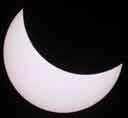 This image of the partial eclipse was taken about 36
minutes before second contact. Note the sunspots.
This image of the partial eclipse was taken about 36
minutes before second contact. Note the sunspots.
TIFF View
10:35:40 UTC ( 4 seconds before 2nd Contact)
1/1250 @ ISO 100
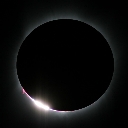
This view taken seconds before second contact shows several large
prominences. The last remaining visible edge of the sun forms a
"diamond ring".
2nd contact was estimated to occur at 10:35:44.
TIFF View
10:35:43 UTC (within second of 2nd contact)
1/320 @ ISO 100
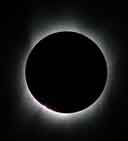 This view showing the inner corona was taken just
before 2nd contact. The last beads of the brightest part of the sun are
still visible.
This view showing the inner corona was taken just
before 2nd contact. The last beads of the brightest part of the sun are
still visible.
The prominences that are easily seen in 10:35:50 are mostly washed out due
to their brightness. This frame starts showing the very complex corona
structure. Note particularly on the left side of the sun. Other
corona shots will develop this further.
TIFF View
10:35:50 UTC Prominences
1/2500 @ ISO 100
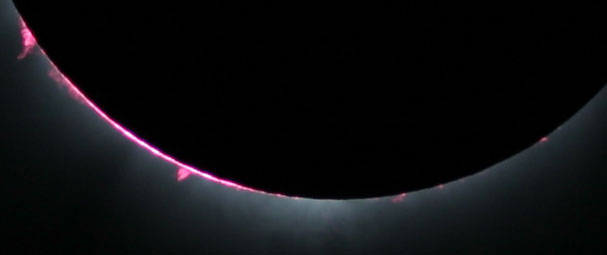 This frame shows is a better exposure of the
prominences than 10-35-43.
This frame shows is a better exposure of the
prominences than 10-35-43.
TIFF View
10:36:19 UTC Inner Corona
1/250 @ ISO 100
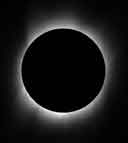 This shot shows more detail in the inner corona and is
a better exposure than the 1/320 above. Note the fine structure at the
top and bottom of the sun.
This shot shows more detail in the inner corona and is
a better exposure than the 1/320 above. Note the fine structure at the
top and bottom of the sun.
TIFF View
10:36:26 UTC
1/80 @ ISO 100
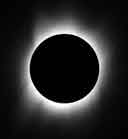 As the eclipse progressed slower images were
taken. This image at 1/80 shows more detail in the inner corona, but
the corona close to the sun shown in 10:36:19 is starting to become
overexposed.
As the eclipse progressed slower images were
taken. This image at 1/80 shows more detail in the inner corona, but
the corona close to the sun shown in 10:36:19 is starting to become
overexposed.
The beginnings of the streamers that were observed with the unaided eye are
starting to appear on the top an bottom of the sun. The deep magnetic
lines on the sides are also becoming more obvious
TIFF View
10:36:44 UTC Outer Corona
1/20 @ ISO 200
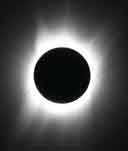 This image is starting to show the outer corona.
Two large streamers at 10'o'clock and at 8'o'clock are now becoming more
definite. A smaller streamer at 2'o'clock is also becoming visible.
This image is starting to show the outer corona.
Two large streamers at 10'o'clock and at 8'o'clock are now becoming more
definite. A smaller streamer at 2'o'clock is also becoming visible.
The magnetic lines at the sides of the sun are starting to become
overexposed.
TIFF View
10:37:36 UTC
1/10 @ ISO 400
 This final full frame shot of the corona shows its
extent. In slower images the structure was overexposed. The streamers
from the previous frame and several other dimmer ones are now well
defined. The asymmetric shape between the sides and the top and bottom
that gave the bow tie appearance with the unaided eye is now visible.
This final full frame shot of the corona shows its
extent. In slower images the structure was overexposed. The streamers
from the previous frame and several other dimmer ones are now well
defined. The asymmetric shape between the sides and the top and bottom
that gave the bow tie appearance with the unaided eye is now visible.
I estimate that the streamers extended about 1 1/2 sun diameters.
TIFF View
Warning (48 Meg)
10:37:44 UTC Earthshine
1/5 @ ISO 1600
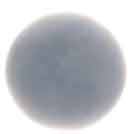 This is the slowest image taken
near the time of max totality. This image is cropped so only the moon is
showing. The rest of the frame is over exposed corona. This frame did
not show the corona extending more than the 10:37:36 shot.
This is the slowest image taken
near the time of max totality. This image is cropped so only the moon is
showing. The rest of the frame is over exposed corona. This frame did
not show the corona extending more than the 10:37:36 shot.
Earthshine on the moon is apparent in this image.
TIFF View
10:38:59 UTC Prominences on Other Side of Sun
1/1250 @ ISO 100
 As 3rd contact approached prominences on the
opposite side of the sun started appearing. Here they are just peaking
out over the lip of the retreating moon.
As 3rd contact approached prominences on the
opposite side of the sun started appearing. Here they are just peaking
out over the lip of the retreating moon.
TIFF View
10:39:32 UTC
1/2500 @ ISO 100
 As 3rd contact approached a ring of fire
appeared across the side of the moon. Note the detail in the dimmer
ones at the top of the sun. This was near the time I stopped looking through
the camera and just used used my eyes again.
As 3rd contact approached a ring of fire
appeared across the side of the moon. Note the detail in the dimmer
ones at the top of the sun. This was near the time I stopped looking through
the camera and just used used my eyes again.
TIFF View
10:36:46 UTC After 3rd contact
1/1250 @ ISO 100
 This image was taken a couple of seconds after third
contact. The 10:36:42 image showed some evidence of brightening.
This image was taken a couple of seconds after third
contact. The 10:36:42 image showed some evidence of brightening.
In this image a distinct bead is visible to the left of the main image of
the appearing sun. The prominences are also visible.
TIFF View
Copyright © 2006, 2012, 2016 Robert J. Hawley Some Rights Reserved.
rjh 11/3/16


 This image of the partial eclipse was taken about 36
minutes before second contact. Note the sunspots.
This image of the partial eclipse was taken about 36
minutes before second contact. Note the sunspots.
 This view showing the inner corona was taken just
before 2nd contact. The last beads of the brightest part of the sun are
still visible.
This view showing the inner corona was taken just
before 2nd contact. The last beads of the brightest part of the sun are
still visible. This frame shows is a better exposure of the
prominences than 10-35-43.
This frame shows is a better exposure of the
prominences than 10-35-43. This shot shows more detail in the inner corona and is
a better exposure than the 1/320 above. Note the fine structure at the
top and bottom of the sun.
This shot shows more detail in the inner corona and is
a better exposure than the 1/320 above. Note the fine structure at the
top and bottom of the sun. As the eclipse progressed slower images were
taken. This image at 1/80 shows more detail in the inner corona, but
the corona close to the sun shown in 10:36:19 is starting to become
overexposed.
As the eclipse progressed slower images were
taken. This image at 1/80 shows more detail in the inner corona, but
the corona close to the sun shown in 10:36:19 is starting to become
overexposed. This image is starting to show the outer corona.
Two large streamers at 10'o'clock and at 8'o'clock are now becoming more
definite. A smaller streamer at 2'o'clock is also becoming visible.
This image is starting to show the outer corona.
Two large streamers at 10'o'clock and at 8'o'clock are now becoming more
definite. A smaller streamer at 2'o'clock is also becoming visible. This final full frame shot of the corona shows its
extent. In slower images the structure was overexposed. The streamers
from the previous frame and several other dimmer ones are now well
defined. The asymmetric shape between the sides and the top and bottom
that gave the bow tie appearance with the unaided eye is now visible.
This final full frame shot of the corona shows its
extent. In slower images the structure was overexposed. The streamers
from the previous frame and several other dimmer ones are now well
defined. The asymmetric shape between the sides and the top and bottom
that gave the bow tie appearance with the unaided eye is now visible. This is the slowest image taken
near the time of max totality. This image is cropped so only the moon is
showing. The rest of the frame is over exposed corona. This frame did
not show the corona extending more than the 10:37:36 shot.
This is the slowest image taken
near the time of max totality. This image is cropped so only the moon is
showing. The rest of the frame is over exposed corona. This frame did
not show the corona extending more than the 10:37:36 shot. As 3rd contact approached prominences on the
opposite side of the sun started appearing. Here they are just peaking
out over the lip of the retreating moon.
As 3rd contact approached prominences on the
opposite side of the sun started appearing. Here they are just peaking
out over the lip of the retreating moon. As 3rd contact approached a ring of fire
appeared across the side of the moon. Note the detail in the dimmer
ones at the top of the sun. This was near the time I stopped looking through
the camera and just used used my eyes again.
As 3rd contact approached a ring of fire
appeared across the side of the moon. Note the detail in the dimmer
ones at the top of the sun. This was near the time I stopped looking through
the camera and just used used my eyes again. This image was taken a couple of seconds after third
contact. The 10:36:42 image showed some evidence of brightening.
This image was taken a couple of seconds after third
contact. The 10:36:42 image showed some evidence of brightening.